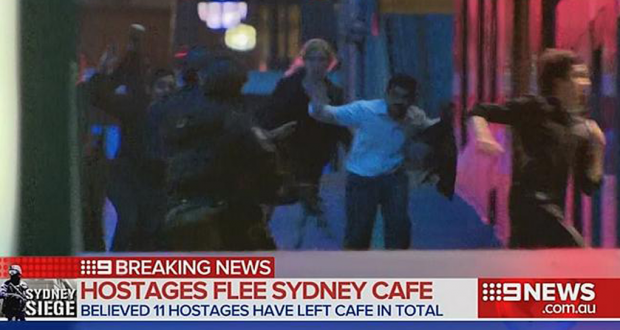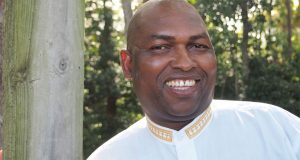Australians were glued to their screens last December during the Lindt café hostage drama. What can we learn from the way the tragedy unfolded? Dianne Jensen reports.
We all remember those first images of hostages holding up a black flag with white Arabic writing in the window of the Lindt café. The crisis in Sydney’s central business district absorbed our attention as rolling coverage via television, radio and online media platforms provided a ring seat to the seventeen-hour drama.
During the day and into the early morning the mix of updates, analysis and on-the-spot commentary was interspersed with looping replays of the few bursts of activity. We kept a helpless vigil as we watched the shadowy faces behind the window and glimpsed the terror of the fleeing hostages.
Barrister Katrina Dawson and Lindt café manager Tori Johnson were killed during the December siege, along with gunman Man Haron Monis.
The Lindt café siege was not the first act of violence in Australia with conjectural links to religious extremism, but it has placed the question of how we respond to the saturation coverage provided by both old and new media squarely on the agenda.
Too much information?
Dr John Harrison, journalism program director at the School of Communication and Arts at the University of Queensland agrees it is important to consider the role played by media outlets in shaping our perception of what happened, and even the way in which the events unfolded.
“There are complex ethical decisions that news producers have to make, often with very little time to reflect on any unintended consequences. Certainly during the Sydney siege, news organisations collaborated with the authorities in not broadcasting information that may have helped the perpetrator. They clearly acted in the public interest.”
John adds that many media commentators have expressed serious reservations about the rolling coverage of such events, particularly by television.
“I know from my Twitter interaction with him that Paul Barry from the ABC Media Watch program shares my concern that seemingly endless rolling coverage easily degenerates into hypothetical speculation which fails to meet the public interest test. Indeed, such coverage can be a form a public spectacle, even a ghoulish form of entertainment.”
The role of social media, particularly Twitter, is critical in situations of live reporting, says John.
“There are many who are critical of the bile that spews forth on Twitter, and a lot of old-school journos are ambivalent about the platform. However for journalists, Twitter is always the first platform of choice for breaking news. And as with traditional media such as newspapers, radio and television, you need to be selective about what you read and who you believe.
“Moreover, social media provides an immediate corrective to misinformation, through what we call ‘the wisdom of crowds’. It is impossible these days for a public figure to make a claim of dubious veracity, without an immediate corrective chorus from social media.”
John believes that new media platforms provide an opportunity to create social capital.
“I’m optimistic about the role of social media in connecting people, and fostering dialogue and debate, particularly dialogue and debate for which the agenda is not set by mainstream media.”
Truth comes at a price
The hostage drama regained traction in the public space with the coverage of the ongoing inquest into the three deaths which began at the Glebe Coroners Court at the end of January.
This was followed in early February by the commercial television interviews with survivors who had agreed to sell their stories, with Channel Nine’s 60 Minutes winning the ratings battle against Channel Seven.
But not everyone elected to watch. The Guardian noted that “Despite the intense competition between the two networks, the extensive promos and the acres of news reports devoted to the siege, more Australians opted for lighter fare: My Kitchen Rules and The House of Hancock.”
Were Australians weary of thinking about the incident, or did the commercialisation of the tragedy rankle? Maybe there was just something better on.
Ethicist and former journalist Trevor Jordan says that there are a number of ways in which people react to the saturation media coverage of violent events, especially so close to home.
“We are hard-wired for ‘fight’ or ‘flight’ and the array of emotions that go with it. We can respond to this anxiety in a number of ways. We can, for example, avoid it, deny it, rationalise it or drug over it,” says Trevor.
“Rationalising violence takes many forms, from the simple, ‘They had it coming to them’ to the more sophisticated ideological point scoring or historical justification based on past wrongs. Much rationalising also results from racial or ethnic stereotyping.”
Trevor says that viewers need to remember that the bottom line of media coverage is always ratings.
“The primary role of the media is to get viewers and listeners. Emotional links to tragic events are regularly used to promote station product—linkages we would find unacceptable in marketing other products.”
Christians have a duty to seek out the truth, he says, and this means that we must walk a different path when we are confronted by public incidents which engender anger, fear and grief.
“A better way of dealing with our anxieties about violent events is to share those anxieties with others, find out we are not alone and to put some perspectives on them.
“The starting point for most Christians would be prayerful reflection. Handing our anxieties over to God, calming our minds, cultivating a mindful solidarity with all who suffer, and opening our hearts and minds to possible responses.
“A prayerful attitude helps us to accommodate our responses to the rhythms of the Gospels rather than those of the media, which in the case of live saturation coverage are often unhelpfully immediate and instinctive. Christians are lucky. We are part of a global community of faith. We have pathways for solidarity.”
Taking time to mourn
Dealing with the anxiety and anger engendered by a climate of violence and fearfulness is an important pastoral issue, says Synod chaplaincy educator Lynne Gibson, and churches have a role to play in the community.
“Grief can be confronting to witness. We can become fearful for ourselves and our loved ones, feeling helpless and overwhelmed. For some, past losses can resurface and our grief becomes deeply personal.”
Holding special services can provide an opportunity for community mourning, Lynne suggests.
“There is comfort in togetherness, hope, and the healing power of ritual provides an avenue for moving forward.”
 JourneyOnline
JourneyOnline







